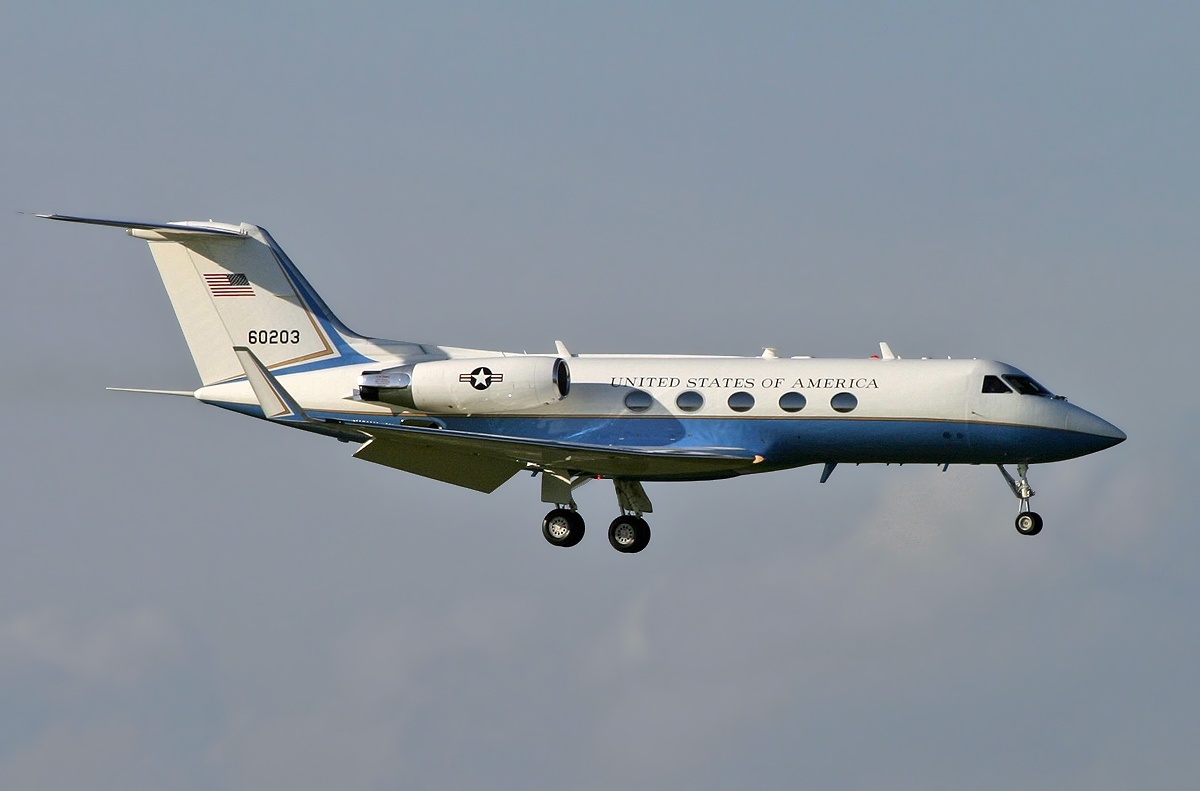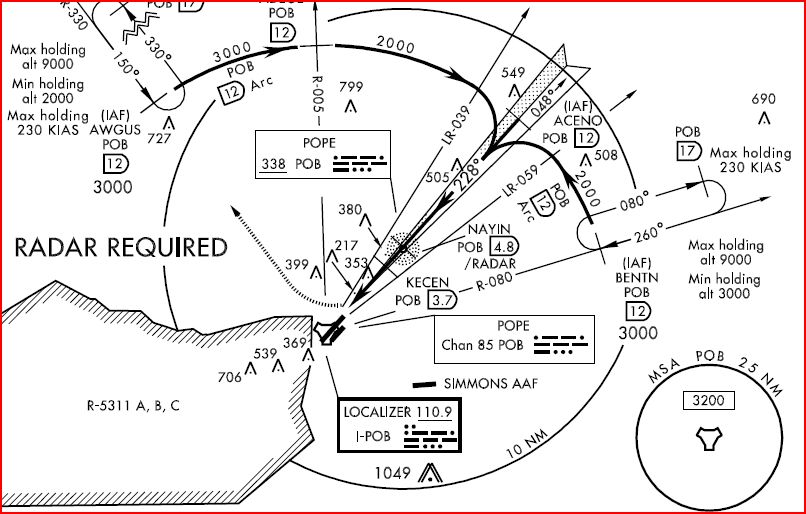I showed up at Andrews as the most senior pilot they had hired in many years and so was spared some of the ritual eating of one's young. But I still had to deal with my share of dinosaurs trying to fight the onslaught of technology presented by our brand new Gulfstream IIIs. Many of the geriatric set were holding on to their "seat of the pants" methods but the Gulfstream outperformed anything they had flown before. Things were not going smoothly, I found out.
— James Albright

Updated:
2012-07-07
I became one with the concept of 60 nautical miles to 1 degree about six years prior to this story and had become evangelical about its application. At the 89th, however, I had to tread lightly for they were deeply devoted to the concept of . . .

That looks about right
Back to "Shut Up and Learn" Mode. I assumed the attitude with each new airplane. I was flying a Gulfstream III as a copilot for the 89th Military Airlift Wing. It didn’t matter that I had been an aircraft commander and instructor pilot twice before. At the 89th you were a nobody until you upgraded to aircraft commander of an 89th airplane. I was a nobody flying with a very senior instructor pilot, Lieutenant Colonel John Katzenberg. Colonel Katzenberg. was a child of TLAR, “That Looks About Right.”
Colonel Katzenberg. had a chip on his shoulder for young upstarts like me and greeted me gruffly, only saying “We have six legs, I’ll fly the first three; you get the last three.”
We were flying the Philippine Army Chief of Staff on a tour of several east coast army bases before depositing him back at LaGuardia Airport in New York. Colonel Katzenberg. would fly him from Andrews to Langley Air Force Base, Virginia, Fort Smith, Arkansas, and to Pope Air Force Base, North Carolina. I would take him the rest of the way.
The criteria for a successful landing for an 89th crew were unlike anyplace else in the Air Force, probably the world. A good landing followed a very smooth flight and touchdown, and was followed by the air stairs hitting the red carpet plus or minus five seconds. We made this happen routinely, but the workload was insanely high and everyone in the cockpit had a role to play.
During our approach into Langley I was supposed to back up the pilot’s timing while negotiating any required preferential treatment with air traffic control. Colonel Katzenberg’s timing was perfect but his approach angle was too steep. The Gulfstream III likes to descend on a 3 degree glide path, 4 degrees was okay, 5 degrees was too high. We were cleared for a visual approach from 30 miles out and Colonel Katzenberg was delaying his start of descent. At 10 miles we were still at 5,000 feet. The 60 to 1 rule says divide altitude to lose in hundreds of feet by the distance to go to determine the angle. Since Langley was near sea level the altitude to lose was 50 hundreds of feet. 50 divided by 10 is 5.
“Colonel you are too steep,” I said, “I figure you need a five degree descent rate from here. You need to either steepen it here so you can dish it out later, or you . . .”
“I’m okay,” he said, “I’ve heard this about you, major.”
He pulled the throttles back a bit and I saw the vertical velocity indicator increase. “You see flying has nothing to do with math,” he continued, “it is more about feel. When you get about five years in the jet, you will have the necessary feel. These things take time.”
In a few minutes we were back on the three degree glide path and a few minutes later Colonel Katzenberg. had one of those landings where you had to ask tower, “Are we on the ground yet?” It was smooth. Oh yes, the stairs hit the red carpet at ETA plus one second.
The weather for the entire week was supposed to be CAVU — ceiling and visibility unlimited — and the next day we were once again cleared for a visual approach early. We were at 10,000 feet with clearance to begin our descent as we saw fit. Once again, Colonel Katzenberg. didn’t see fit. Not only was the angle was going to be a problem, he was early. The Gulfstream III doesn’t do steep angles well because of speed limits on the gear and flaps. At 25 miles we were still at 10,000 feet. Under 60 to 1 that comes to a 4 degree glide patch. Even most TLAR pilots shoot for 40 miles at 10,000 feet. But I was chided the day before so I kept my mouth shut. Even if he made the angle, the timing was going to be problem. The runway at Fort Smith had several taxiways exiting the runway, giving us lots of flexibility for the block time, but I figured Colonel Katzenberg. needed to lose a full minute on top of all the other possible tricks. But if he blew the descent, all timing would go out the window anyway.
At 20 miles we still hadn’t started. “Colonel,” I said, “do we need to start down?”
“I warned you once before,” he said. That was enough to silence me.
At 17 miles he pulled the throttles to idle and pointed the nose to the runway. That came to six degrees. I’ve seen that angle fail before. This time it worked perfectly. That night I relived the descent over and over and realized the mistake was mine. From 20 miles to 17 miles the Colonel was decelerating and that not only solved his timing issue it allowed him to descend with an extra notch of flaps. My math still worked, but it needed to make allowance for the various flap settings on our aircraft.
The next day’s trip was to Pope Air Force Base which meant I would be dealing with Air Force controllers, making my life easier because they understood the importance of our Special Air Missions aircraft. Pope is in Fayetteville, North Carolina, right next to Fort Bragg. That only mattered because at the south east end of the airport there laid Restricted Area 5311, what the army called its “High Trajectory Range.” I had been into Pope many times and it wasn’t a problem, you just had to avoid the area and the flying ammunition and you would be okay.
I wasn’t thinking about anyone’s high trajectory other than our own as Colonel Katzenberg. began his third visual descent in three days. We were at 250 knots—too fast for flaps or the landing gear—and 8,000 feet with only 12 miles to go, almost 7 degrees. I had twice seen Colonel Katzenberg. make descents that I thought impossible. He pulled the throttles to idle and I kept my mouth shut. In another minute we were at 7,000 feet, slowing nicely, but the distance shrunk to 9 miles. Quick math: 70 divided by 9 is almost 8. Two days ago 5 worked nicely. Yesterday 6 worked, barely. “Sir?” I said tentatively.
“I warned you already,” he said, “gimme flaps 10.”
I did as requested. Now we could clearly see the airport below us. With only 5 miles to go we were still at 5,000 feet. Ten degrees! Things got worse and we struggled to get our speed low enough for the landing gear. At the 2 mile point we were still too fast and too high.
“Sam Six Oh Two,” tower called, “you going to make it?”
“Sir?” I asked again. Colonel Katzenberg. said something under his breath I didn’t catch.
“Sam Six Oh Two,” tower called again, this time with a higher pitch, “the restricted area is hot. Say intentions.”
“Colonel?”
More silence. We were now over the runway, falling like a rock, but still about 1,500 feet in the air. I could see the restricted area and we were still at pattern altitude! Ah, I thought to myself, we could do a closed pattern from here. I keyed the mike. “Sam Six Oh Two request midfield closed.”
“Hey,” the surprised controlled shouted, “that will work! Closed approved.”
Colonel Katzenberg. banked sharply to the right and started apologizing, nonstop. We touched down three minutes late and he apologized some more. We blocked in a minute late and there were more apologies. That night at the bar he kept ordering beer for me and refused my efforts to pay. He peppered me with questions about 60 to 1. “I’ve got to learn this,” he said, “and you have to teach me.”

